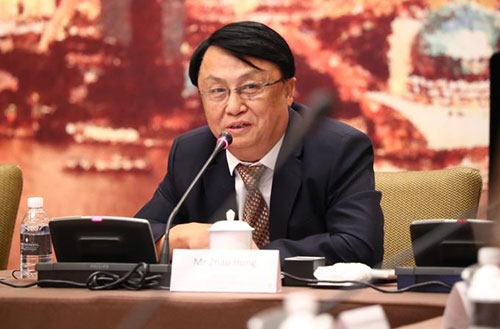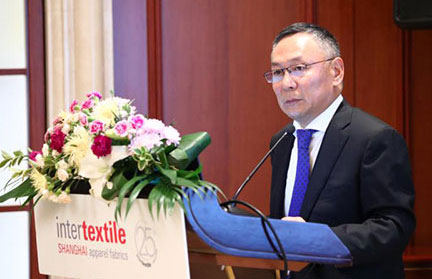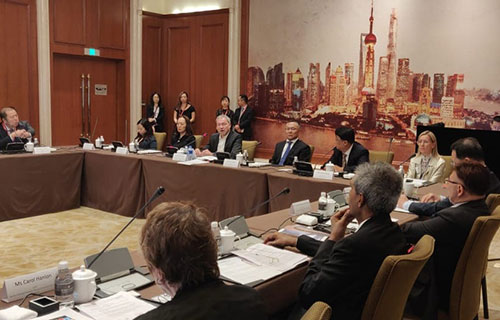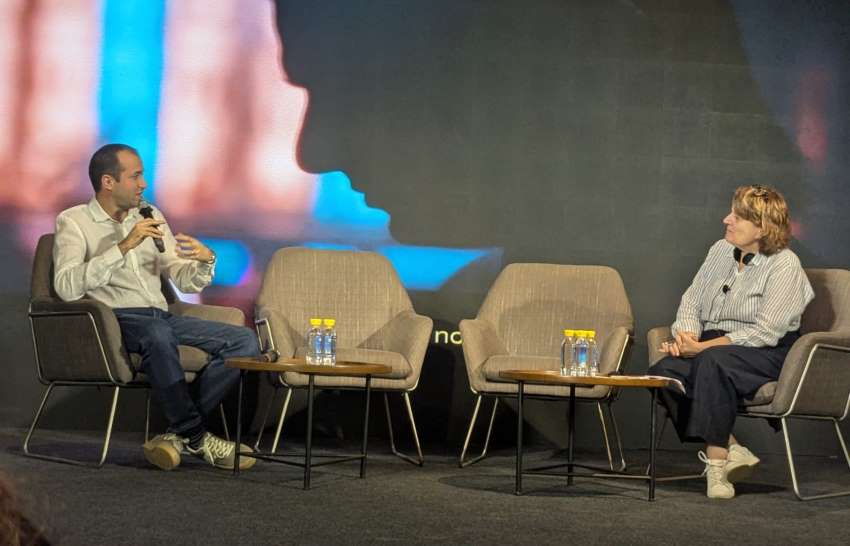FW
"The Chinese textile industry has become a key player after decades of reform. In 2018, Chinese production of chemical fibers made up over two thirds of the global production. “Textile exports from the country also increased by 3.5 per cent to reach 37.6 per cent of the world’s total in 2018, while apparel exports accounted for 31.3 per cent of the total world’s total exports"
 Advanced manufacturing and additional investments in companies across the world, have made China the world’s biggest textile market. To exploit the growing potential of this market, the 25th Autumn Edition of Intertextile Shanghai Apparel Fabrics organised a private round table meeting on September 25, 2019. The conference included a keynote speech and a panel discussion. Olaf Schmidt, Vice President of Textiles & Technologies at Messe Frankfurt delivered the welcome speech. “Through this fair, we aim to curate a fringe programme that will inform, engage and connect thought leaders from across the world,” he said.
Advanced manufacturing and additional investments in companies across the world, have made China the world’s biggest textile market. To exploit the growing potential of this market, the 25th Autumn Edition of Intertextile Shanghai Apparel Fabrics organised a private round table meeting on September 25, 2019. The conference included a keynote speech and a panel discussion. Olaf Schmidt, Vice President of Textiles & Technologies at Messe Frankfurt delivered the welcome speech. “Through this fair, we aim to curate a fringe programme that will inform, engage and connect thought leaders from across the world,” he said.
Xu Yingxin, Vice President of the China National Textile and Apparel Council and Chairman of CCPIT-TEX (co-organiser of the fair) delivered the keynote address, titled: The Current Situation of China’s Textile Industry. The main takeaways from the keynote address and the panel discussion were:
High demand from the domestic market
The Chinese textile industry has become a key player after decades of reform. In 2018, Chinese production of chemical fibers made up over two thirds of the global production. “Textile exports from the country also increased by 3.5 per cent to reach 37.6 per cent of the world’s total in 2018, while apparel exports accounted for 31.3 per cent of the total world’s total exports,” noted Yingxin 
Although the purchasing power of Chinese consumers has slowed slightly, country’s textile industry is still experiencing high demand from the domestic market. “Our huge population offers our apparel industry a huge safety net as clothing is a necessity rather than a luxury,” Yingxin observed. However, though apparel sales have continued to grow in 2019, the pace of growth slowed.
Emphasis on creating a strong consumer economy
The panel discussion also focused the importance of a strong consumer economy in order to maintain high domestic purchasing power. Paul Alger, UK Fashion & Textile Association warned of the social consequences and lack of purchasing power caused due to a weak consumer economy. KV Srinivasan, TEXPROCIL indicated that India’s consumer economy benefits from their strength, including a rich textile heritage and skilled technical workforce.
Three missions to develop the textile industry
China’s textile investments in 2019 focused on technology and innovation, resulting in increased productivity. The Autumn edition of Intertextile Shanghai Apparel Fabrics noted three key missions for China’s progress including technology and innovation; culture and local talent; and sustainability.
The panel discussion further focused on sustainability. Carol Hanlon, Textile Clothing Footwear Resource Centre, Australia pointed out “As a leader of textile production, China has the capacity to drive change in circularity. There will be a demand for sustainability in the future as younger generations are increasingly associated with climate activism.”
Burgeoning investments strengthen manufacturing, increase co-operation
During the first five years of the Belt & Road initiative, total trade volume between China and other countries along the Belt & Road route exceeded $6 trillion, accounting for nearly a third of China’s total trade in goods during this period. By 2018, the country reportedly invested $6.5 billion in countries along the Belt & Road route. These investments offer a two-fold benefit to China. They build efficient manufacturing bases along the Belt & Road route besides increasing international co-operation to strengthen resources throughout the supply chain.
China creating opportunities for other countries
China exports around 18 per cent its textiles to the US. It is also the largest exporter of textiles and apparel to the US, accounting for 38 per cent of the nation’s total imports. This is creating new opportunities for other countries to explore the US market. Ade Sudrajat, Indonesian Textile Association noted, “We aim to develop our local e-commerce and start-ups.”
Autumn 2019 Edition of Intertextile Shanghai Apparel Fabrics was held from September 25-27, 2019 in Shanghai. The event was co-organised by Messe Frankfurt (HK) alongwith Sub-Council of Textile Industry, CCPIT; and the China Textile Information Centre.
Japanese company Nippon Koei plans to invest in the Cambodian silk industry. This investment will improve the domestic silk market which is currently facing competition from increasing imports.
The Cambodian silk sector currently faces challenges such aslack of raw materials, human resources and financial resources. Secondly, handmade Cambodian silk cannot compete with low cost imported silk products.
The country imports silk and cotton yarn from China, Vietnam and Thailand due to the lack of locally produced raw materials. As the National Silk Strategy Report 2016-2020 reveals, the country’s silk yarn production accounts for only one per cent of total domestic consumption, while its imports accountfor 99 per cent – equivalent to more than 400 tonne per year. This imported silk can be used to make a wide range of products such as ties, clothing, bags, and items for home decor, hotels, shops and others.
The Smart Myanmar project launched by the EU aims at improving social and environmental performance at more than 100 garment and textile factories across the country.
With support from engineers and local and European experts, the project will deliver on-site assessments and training on topics such as human resource management systems and workplace communications, occupational safety and health, chemicals and waste management, and energy efficiency. The aim is to foster decent work conditions and responsible business practices in Myanmar. The initiative has carried out training and consultancy programs with 299 garment, textile and footwear factories since 2016, implementing thousands of improvements related to safe workplaces, effective HR management and energy efficiency. Now the focus is on further strengthening sustainable production practices and responsible supply chains in Myanmar and Europe.
Since 2013, Myanmar’s garment sector has witnessed a staggering export-oriented growth. The garment industry has served largely the European market and created job opportunities for thousands, mostly women. Europe is one of the world’s largest consumer markets and European consumers pay a lot of attention where the products they buy come from and how they are produced. Sustainable production and respect for international labor standards are therefore important topics in the EU’s trade relations with Myanmar.
The US government has strengthened labor, environmental, pharmaceutical and enforcement provisions in the US-Mexico-Canada Agreement (USMCA), setting the stage for its passage. The new USMCA includes several improvements that would greatly benefit the U.S. textile industry and bolster the $20 billion in annual trilateral textile and apparel trade.
The key updates and modifications that USMCA makes over NAFTA include creation of a separate chapter for textiles and apparel rules of origin with strong customs enforcement language, and stronger rules of origin for sewing thread, pocketing, narrow elastics and certain coated fabrics.
Under the current NAFTA, these items can be sourced from outside the region. USMCA fixes this loophole and ensures these secondary components are originating to the region.
In addition, USMCA fixes the Kissell Amendment Buy American loophole, ensuring that a significant amount the Department of Homeland Security spends annually on clothing and textiles for the Transportation Security Administration benefits domestically produced products.
Panda Biotech, based in the US, is developing its first industrial hemp processing facility to produce high-quality, textile-grade fiber and premium cellulose. The facility is expected to be the largest hemp decortication center in the United States and one of the largest in the world. Panda Biotech will deploy the most technologically advanced, highest capacity and first-of-its-kind industrial hemp decorticating equipment ever used to separate the fiber and cellulose from the stalk. To ensure the highest quality fiber, the company will only process hemp stalks that are harvested prior to the maturation of the seed and the flower. Panda Biotech is a first-mover in the emerging US industrial hemp fiber and cellulose industry. The company is currently developing industrial hemp processing facilities.
Processing of the hemp stalk for industrial uses is expected to be the next multi-billion-dollar business in the United States. Hemp fiber and cellulose can help manufacturers meet the needs of today’s eco-conscious consumers who increasingly require environmentally friendly products and services. Hemp is seen as a game changer for both agriculture and industry for generations to come. Processed fiber and cellulose from industrial hemp can be used in the production of a multitude of products including textiles.
During 2018-19, Burberry reduced its market-based emissions by 43 per cent. In the same period, the brand procured 58 per cent of its total energy (including 68 per cent of its electricity) from renewable sources. Burberry is now carbon neutral across the Americas region, its EMEIA retail stores and UK operations and aims at being 100 per cent carbon neutral by 2022. It has set two new, ambitious climate goals approved by the Science Based Target initiative for its own operations and extended supply chain. Burberry has partnered with UN Climate Change to launch the UN Fashion Industry Charter for Climate Action in 2018. The charter aims to drive change across the fashion industry with an initial goal of reducing aggregate greenhouse gas emissions by 30 per cent by 2030. Aligned with the goals of the Paris Agreement, the charter is looking at how fashion can address climate change, from reducing carbon impacts at production stage, selecting climate friendly and sustainable materials to exploring circular business models, improving consumer dialogue and awareness and working with policymakers to catalyse scalable solutions.
Burberry intends for every single product it sells to have at least one positive attribute by 2022. Some products might be made out of an environmentally-friendly material, like its newly introduced Econyl made from recycled fishing nets. Others might use traditional materials, but they are manufactured at a carbon-neutral factory.
From April to September 2019 exports of readymade garments from India increased by just 2.2 per cent. Indian exports are not competitive. Textiles from India are around 10 per cent costlier than textiles from other countries. Also Bangladesh, Sri Lanka and Vietnam have low production costs and their exporters enjoy preferential duty access to key markets. In comparison Indian exporters face higher trade barriers in the US and the European Union. Bangladesh’s exports to the EU face zero per cent tariff and exports to the US face 3.9 per cent tariff. Indian textile exports face six per cent tariff in the EU and 6.2 per cent tariff in the US.
In an attempt to counter subdued exports, Indian readymade garment exporters are creating modalities to make a portal or a central database, where they can list their products according to categories to assist buyers. Buyers will be able to reach out to potential exporters easily through this mechanism. The software will send mailers/alerts to all exporters who produce such items and also to the importer; this would happen when an importer searches for a certain product. This is expected to increase buyer-seller interface and hence help exporters as well as importers.
Gujarat’s cotton production may fall by 10 to 15 per cent. The main reason is unseasonal rains coupled with the menace of pink bollworm, an insect known for being a pest in cotton farming. Due to the unseasonal rains, the cotton crop is affected by higher moisture. As a result, farmers are selling their yield in the open market at relatively lower prices. Against the minimum support price of Rs 5550 a quintal, farmers are earning around Rs 4000 to Rs 5000 per quintal in the open market.
Gujarat accounts for almost 30 per cent of the total cotton production in the country. This ratio is expected to be maintained despite the adverse conditions as the sowing area of cotton in the state has gone up from 23 lakh hectares in the last season to over 26 lakh hectares.
At one time South Indian textile mills reduced their cotton procurement by around 40 per cent from Gujarat. The reason was increased adulteration in cotton. Faced with a growing demand, ginners in Gujarat reportedly started mixing comber waste in the cotton. This propelled many mill owners to tap other parts of the country for cotton procurement to meet the compliance norms set by buyers.
In the last quarter Inditex’s gross margin rose by three tenths compared to the same period of the previous year. The increase in margins also happened at the same time as a reduction in inventories for the second quarter in a row. This was the most profitable period of the year for the group. Efficiencies allowed operating expenses to be kept under strict control during the first nine months of 2019.
However, the recovery achieved in 2019, of three tenths compared to the third quarter of 2018, is moderate. In the fourth quarter of 2018 Inditex’s margin improved only 0.15 points compared to the same period of the previous year. From 2014 to 2017, when practically no one was paying attention to profitability, Inditex was repeatedly losing margin during the third quarter. In this period of 2014, the company’s gross margin stood at 61.2 per cent, almost one point less than a year earlier. This rose to 60.1 per cent a year later, to 59.7 per cent in the third quarter of 2016 and 59.4 per cent to the same period of 2017. In 2018, the group changed its evolution: in the third quarter of that year, margin recovered by more than one point, up to 60.5 per cent of revenue.
Lenzing has brought to India its beauty and body care fiber brand Veocel. Derived from wood, Veocel provides natural care, every day, and is committed to driving industry standards around sustainability and natural comfort in the nonwoven sector. Veocel fibers are certified clean and safe, biodegradable, of botanic origins, and manufactured in an environmentally responsible production process. Veocel offers a broad range of applications that cater to daily use, including beauty, baby care, body and intimate care and surface cleaning. Consumer applications such as face sheet masks, facial cleansing wipes, deodorant wipes, baby wipes, hand sanitizing wipes, intimate wipes, diapers, sanitary napkins, disinfectant wipes etc. made using Veocel branded fibers have distinctive features such as strength, absorbency, liquid management, biodegradability while giving additional features like comfort, cloth-like feel, and smoothness, making it a viable eco-friendly option to choose from.
Lenzing is known for its sustainable fiber brands such as Tencel and Ecovero. With changing consumer habits, more and more nonwoven producers are shifting their product pipelines towards natural and eco-friendly materials to enhance product appeal and open more business opportunities. Lenzing being a pioneer in innovation has helped in fulfilling these needs. Global beauty brands across Europe, the US and Asia have now been using Veocel fibers as part of their product range.












